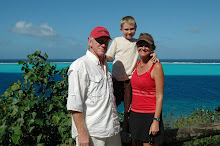
Sunday, September 26, 2010
Bula!

Sunday, September 19, 2010
Vanua Levu Island
Vanua Levu is the second largest island in Fiji and has two distinct climates zones divided by an interior mountain range. On the damper southeast side, copra farming (coconuts used for oil) is the main agricultural industry while sugarcane and pine forests grow in abundance on the dryer northwest side. On the north side, miles of narrow railroad tracks criss-cross the countryside for the sole purpose of transporting sugarcane to the large government-owned mill. The island is littered with small Fijian villages and a main market town on each side of the mountain range. Labosa, the northern town, was our main destination for the tour where we meandered through the market while Jimmy identified unfamiliar fruits and vegetables for us. Savusavu is the market town on the southeast side, where we are anchored in its harbor.
Near the towns, you will find many Indo-Fijian people - descendents from indentured laborers recruited in the late 19th century to work the sugar fields. Although the Indo-Fijians and native Fijians have developed a peaceful co-existence on Vanua Levu, their distinct cultures continue to be obvious in dress, language, religion, food and customs. For example, no Fijians work on Sundays but the Indian shops are open. In other parts of Fiji, tensions between the races continue to be a contentious political matter even 125 years later. Having become an independent republic (under the Commonwealth of Nations and the Queen of England) in 1970, government instability has plagued Fiji ever since, with full blown coups as recently as 2006. The balance of power between Indo-Fijians and Fijians is out of whack. Fijians own most of the land while Indo-Fijians dominate commerce. Even though racial tensions here are subdued, we heard prejudice in our guide Jimmy. He warned us that Indian merchants will charge higher prices to tourists, a practice he found dishonest and dispicable. (We experienced this ourselves when Eric bought the same batteries ranging from $2 to $15!) He told us Fijians do not care about money. They strive to earn only what they need and no more. Indians want more and more, a concept Fijians, and much of native South Pacific, do not understand.
Another tour stop was to Naag Mandir, a Hindu temple designed around a serpent-shaped rock that represents the Hindu snake god. This rock reportedly grows, so much that the roof of the temple has had to be raised to accommodate its larger size. Never having seen a Hindu temple before, I was intrigued by its bright colors and amusement-park architecture qualities. At the top of the 108 steps to view manequin representations of importants gods, I expected there to be a water slide. Each step represents a blessing so the steps were built half-size to create more steps and make climbing easier. Two young Indian girls were there pouring milk offerings to the snake god and others had left food. One of Jimmy's sisters converted to Hinduism so he was able to explain some of the rituals. It seems to be an interesting religion.
Our final stop was the Palmlea Lodge built five years ago and run by friendly ex-cruisers, Joe and Julie. Lunch was fabulous and I got an Indian Pumpkin recipe from the Fijian cook. Bear and I swam in the lap pool while Joe told Eric about his Boer goats that he is breeding to increase the meat yield per animal.
We are just beginning to explore Fiji but so far we are loving it!
Friday, September 17, 2010
Tonga recap
SCUBA
Karting around Tonga
Beer Keg Raft
The Millars visit Tonga
La Paella and the Goat
Thursday, September 16, 2010
Sea Cucumbers
Sea cucumbers are one of the grossest looking and feeling things lying on the sandy ocean bottom. They are long and thick, like a cucumber, but they are very squishy to the touch, almost like holding solid Jell-O. Mostly they are black and look like big, unsightly turds lying in the white sand. Bear loves to pick them up as they are harmless. If the animals become too frightened they expel their apparently untastey guts as a defense mechanism. Very gross! Sea cucumbers are cleaning agents to reefs and are important for keeping them healthy. Some places abound with them - so many that it's difficult to walk in shallow waters without stepping on them. There are many types of sea cucumbers, some spiky, some colorful, and some grow very large (like those rice-filled neck heaters). But all in all, they are necessary to the ecosystem but fairly benign and not useful to the locals.
China has another take on these creatures. Like pricey caviar requiring an acquired taste, sea cucumbers have become a status symbol and are considered a delicacy in China. The government of Tonga has recently issued harvesting licenses to some Chinese companies. The result has been a depletion of the sea cucumbers in Tongan waters and some Toganese reaping great financial benefits - in the short run. We have heard that each sea cucumber is worth between $30-70 Tongan dollars ($15-35 US). (Rarer species are worth more.) An average Tongan worker makes about $30 USD Tongan per day so the appeal to locals is understandable.
Sea cucumber harvesting seems to be a new endeavor so the result on the environment is yet unknown. However, some local pelangi (foreigners) warn this practice could endanger the reefs. And certainly the local economy is being skewed. People the world-over are not immune to ruining their environments in the pursuit of money. When you see it happening in current times, it is difficult to not be, at the least, annoyed, at the most, enraged. In the future, these slimy, unsightly necessary creatures may
Passage to Fiji
Wednesday, September 15, 2010
Departing Tonga
Wednesday, September 1, 2010
Haapi

